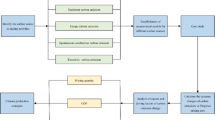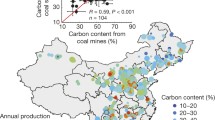Abstract
Coal is the primary source of China’s carbon emissions due to the energy structure and its resource endowment. This reality creates enormous pressure and impetus for low-carbon pathways of coal production and consumption. Based on a literature review on carbon emissions accounting methods, this paper builds a source-driven CO2 emissions accounting model for the coal development sector using the emissions factor method. Scenario analysis is employed to predict future carbon emission equivalents and to indicate possible implications for climate change mitigation in this sector. Carbon emissions from coal development are mainly derived from coal mine gas emissions, which yield 62% of the sector’s total carbon emissions, followed by energy consumption. The recent decline in coal mining-driven CO2 emissions is mainly due to the strict deployment of coal mine gas and the changing structure of coal mines. The results from the scenarios suggest that the carbon emissions reduction potential will largely be determined by technology innovation in the coal mine gas industry. Policy implications for further addressing carbon emissions from the supply side of the coal industry include improvements in energy efficiency and coal mine gas extraction and utilization.





Similar content being viewed by others
References
Bastianoni S, Marchi M, Caro D et al (2014) The connection between 2006 IPCC GHG inventory methodology and ISO 14064-1 certification standard—a reference point for the environmental policies at sub-national scale. Environ Sci Policy 44:97–107
Booth P, Brown H, Nemcik J, Ting R (2017) Spatial context in the calculation of gas emissions for underground coal mines. Int J Min Sci Technol 27:787–794
Chen W, Wu Z, He J et al (2007) Carbon emission control strategies for China: a comparative study with partial and general equilibrium versions of the China MARKAL model. Energy 32:59–72
Deng HM, Liang QM (2017) Assessing the synergistic reduction effects of different energy environmental taxes: the case of China. Nat Hazards 85(2):811–827
Fan JL, Liao H, Liang QM et al (2013) Residential carbon emission evolutions in urban-rural divided China: an end-use and behavior analysis. Appl Energy 101:323–332
Franzen A, Mader S (2018) Consumption-based versus production-based accounting of CO2 emissions: Is there evidence for carbon leakage? Environ Sci Policy 84:34–40
Goglio P, Smith WN, Grant BB et al (2018) A comparison of methods to quantify greenhouse gas emissions of cropping systems in LCA. J Clean Prod 172:4010–4017
Huang L, Krigsvoll G, Johansen F et al (2018) Carbon emission of global construction sector. Renew Sustain Energy Rev 81:1906–1916
Intergovernmental Panel on Climate Change (IPCC) (2006) IPCC guidelines for national greenhouse gas inventories. Institute for Global Environmental Strategies, Hayama
Ji Z, Chen Z, Pan J, Niu Q (2017) A novel method for estimating methane emissions from underground coal mines: the Yanma coal mine, China. Atmos Environ 170:96–107
Jin K, Cheng Y, Wang W et al (2016) Evaluation of the remote lower protective seam mining for coal mine gas control: a typical case study from the Zhuxianzhuang Coal Mine, Huaibei Coalfield, China. J Nat Gas Sci Eng 33:44–55
Kalt G, Höher M, Lauk C et al (2016) Carbon accounting of material substitution with biomass: case studies for Austria investigated with IPCC default and alternative approaches. Environ Sci Policy 64:155–163
Kjendseth M, Mamo S, Kristjansdottir T, Andresen I (2018) Energy and buildings lessons learnt from embodied GHG emission calculations in zero emission buildings (ZEBs) from the Norwegian ZEB research center. Energy Build 165:25–34
Lee CT, Lim JS, Fan YV et al (2018) Enabling low-carbon emissions for sustainable development in Asia and beyond. J Clean Prod 176:726–735
Liu Z (2016) China’s carbon emissions report 2016. Belfer Center for Science and International Affairs, Harvard Kennedy School, Cambridge
Liu D, Xiao B (2018) Can China achieve its carbon emission peaking? A scenario analysis based on STIRPAT and system dynamics model. Ecol Indic 93:647–657
Ma M, Yan R, Cai W (2017) An extended STIRPAT model-based methodology for evaluating the driving forces affecting carbon emissions in existing public building sector: evidence from China in 2000–2015. Nat Hazards 89:741–756
Madzivire G, Maleka RM, Tekere M, Petrik LF (2017) Cradle to cradle solution to problematic waste materials from mine and coal power station: acid mine drainage, coal fly ash and carbon dioxide. J Water Process Eng. https://doi.org/10.1016/j.jwpe.2017.08.012
Meng M, Niu D (2011) Modeling CO2 emissions from fossil fuel combustion using the logistic equation. Energy 36:3355–3359
Mi ZF, Zheng J, Meng J et al (2018a) China’s energy consumption in the new normal. Earth’s Future 6(7):1007–1016
Mi ZF, Meng J, Green F et al (2018b) China’s “exported carbon” peak: patterns, drivers and implications. Geophys Res Lett 45(9):4309–4318
NBSC (2017a) China energy statistical yearbook 2017. China Statistics Press, Beijing
NBSC (2017b) China statistical yearbook 2017. China Statistics Press, Beijing
NDRC (2013) Notice of issue the first ten industries accounting and reporting guidelines of GHG emissions (Trial) by National Development and Reform Commission. 15 Oct 2013. http://www.ndrc.gov.cn/zcfb/zcfbtz/201311/t20131101_565313.html
NDRC (2016) Control to Chinese greenhouse gas emission in 13th five-year period. 7 Nov 2016. http://zwdt.ndrc.gov.cn/fwdt/fwdttzgg/201611/t20161107_825814.html
Pan W, Pan W, Shi Y et al (2018) China’s inter-regional carbon emissions: an input–output analysis under considering national economic strategy. J Clean Prod 197:794–803
Schueler M, Hansen S, Marten H (2018) Discrimination of milk carbon footprints from different dairy farms when using IPCC Tier 1 methodology for calculation of GHG emissions from managed soils. J Clean Prod 177:899–907
Shan Y, Guan D, Liu J et al (2017) Methodology and applications of city level CO2 emission accounts in China. J Clean Prod 161:1215–1225
Sim J (2018) A carbon emission evaluation model for a container terminal. J Clean Prod 186:526–533
Sun C, Ding D, Yang M (2017) Estimating the complete CO2 emissions and the carbon intensity in India: from the carbon transfer perspective. Energy Policy 109:418–427
Tsai MS, Chang SL (2015) Taiwan’s 2050 low carbon development roadmap: an evaluation with the MARKAL model. Renew Sustain Energy Rev 49:178–191
Wang N, Wen Z, Zhu T (2015) An estimation of regional emission intensity of coal mine methane based on coefficient-intensity factor methodology using China as a case study. Greenh Gases Sci Technol 5:437–448
Wang B, Cui C, Zhao Y, Chen M, Yuan XC (2018a) Climate change mitigation in the coal mining industry: low-carbon pathways and mine safety indicators. Nat Hazards. https://doi.org/10.1007/s11069-018-3438-1
Wang Z, Li Y, Cai H, Wang B (2018b) Comparative analysis of regional carbon emissions accounting methods in China: production-based versus consumption-based principles. J Clean Prod 194:12–22
Yang T, Pan Y, Yang Y et al (2017) CO2 emissions in China’s building sector through 2050: a scenario analysis based on a bottom-up model. Energy 128:208–223
Yin L, Liu G, Zhou J et al (2017) A calculation method for CO2 emission in utility boilers based on BP neural network and carbon balance. Energy Proc 105:3173–3178
Yuan L (2018) Strategies of high efficiency recovery and energy saving for coal resources in China. J China Univ Min Technol (social science) 1:3–12
Zhu T, Bian W, Zhang S et al (2018) An improved approach to estimate methane emissions from coal mining in China. Environ Sci Technol 51:12072–12080
Acknowledgements
The authors gratefully acknowledge the financial support from National Natural Science Foundation of China (No. 71704178), Beijing Municipal Excellent Talents Foundation (No. 2017000020124G133), Yue Qi Distinguished Scholar Project of China University of Mining and Technology (Beijing), National Statistical Science Research Project by National Bureau of Statistics of China (No. 2017LY10), and Major Consulting Project of Chinese Academy of Engineering (Nos. 2016-ZD-07, 2017-ZD-03). We also greatly appreciate the comments from the seminar participants in workshop organized by Chinese Academy of Engineering.
Author information
Authors and Affiliations
Corresponding authors
Electronic supplementary material
Below is the link to the electronic supplementary material.
Rights and permissions
About this article
Cite this article
Wang, B., Cui, CQ., Zhao, YX. et al. Carbon emissions accounting for China’s coal mining sector: invisible sources of climate change. Nat Hazards 99, 1345–1364 (2019). https://doi.org/10.1007/s11069-018-3526-2
Received:
Accepted:
Published:
Issue Date:
DOI: https://doi.org/10.1007/s11069-018-3526-2




